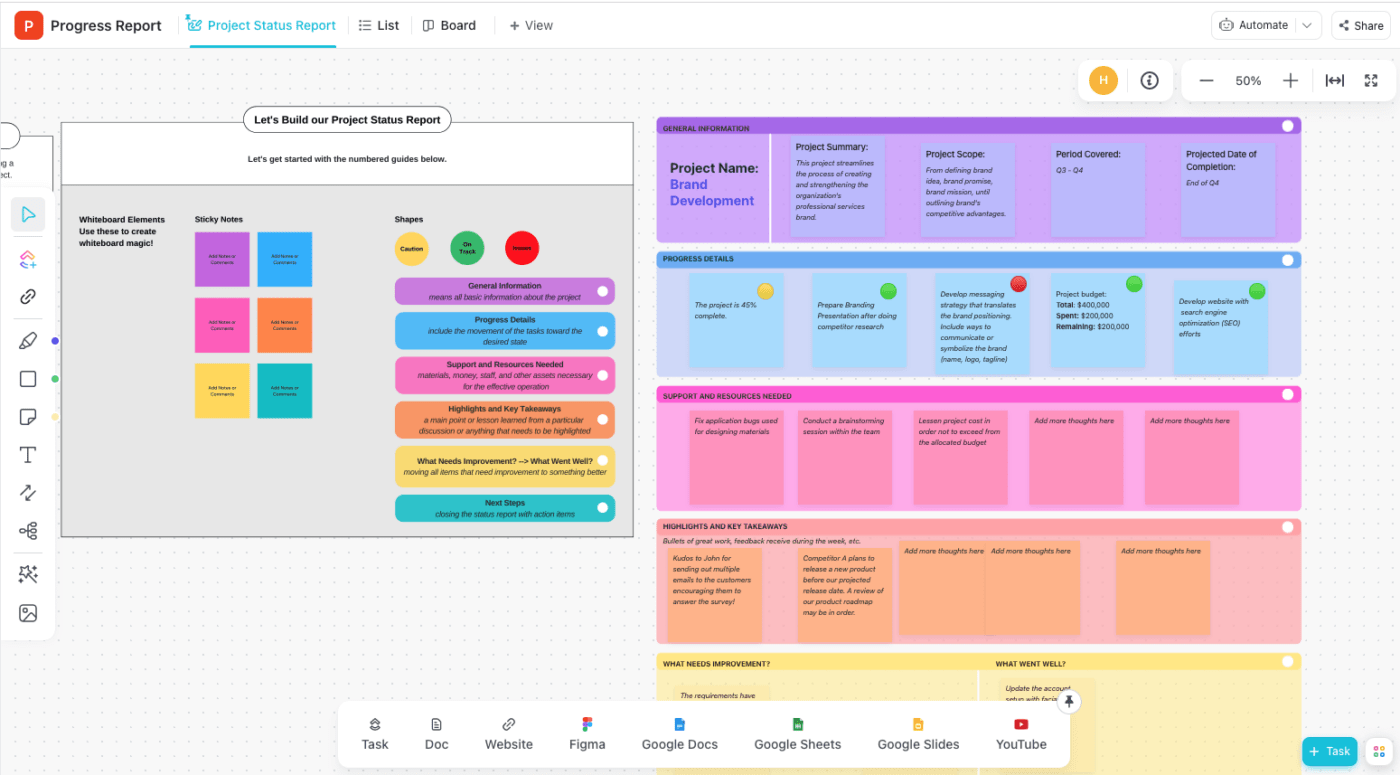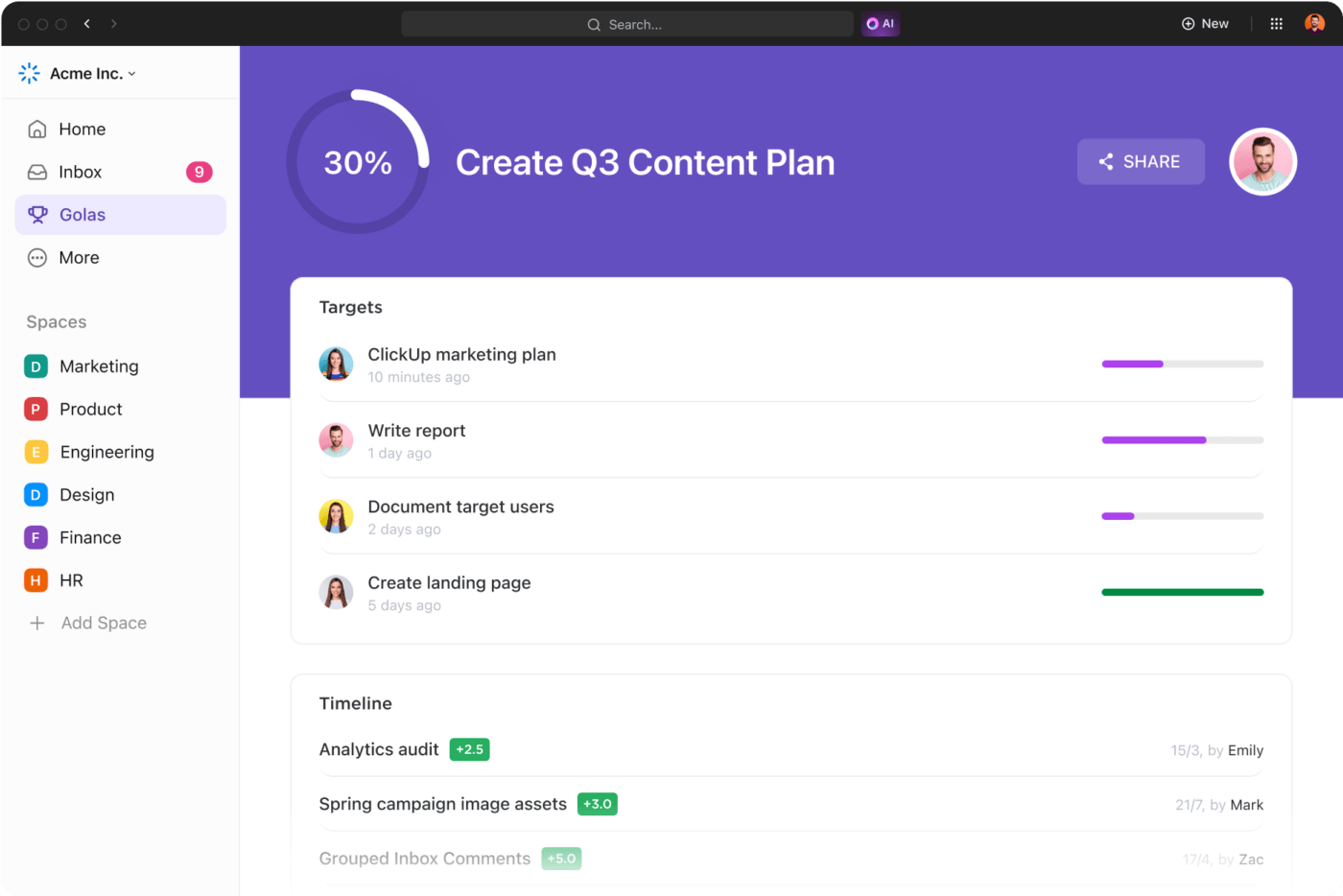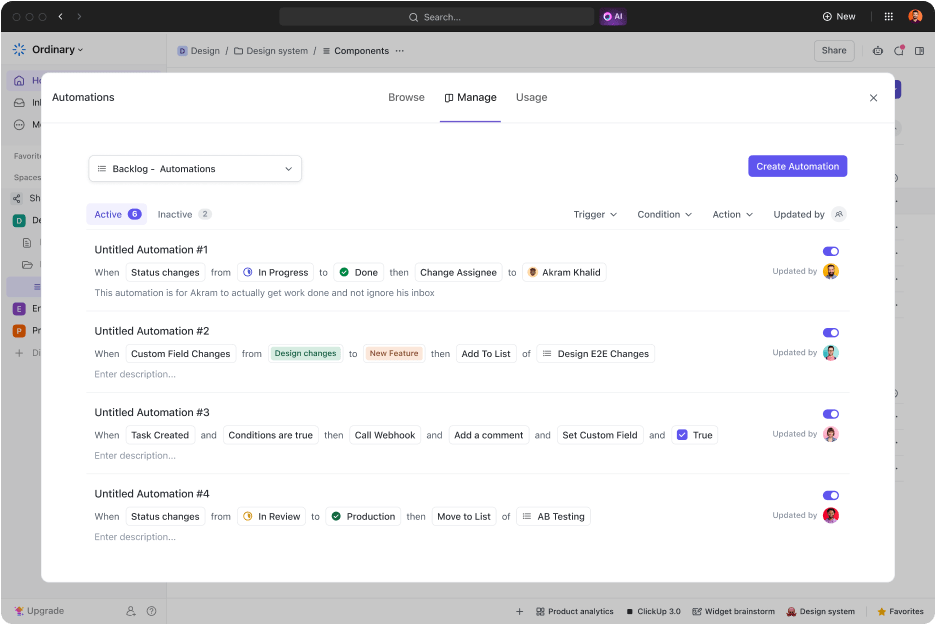

Client reporting is an indispensable tool in many professionals’ toolboxes. 🧰
Although it may sometimes seem like a chore, reporting requires as much care as the work you’re doing for the client. Besides bringing the client up-to-date, reports help them understand your effort and the value it brings to their business. They keep you and the client accountable while preserving your relationship.
To ensure your reports achieve these benefits, you have to follow the client reporting best practices. This article will break down the main client report elements, tackle common challenges, and offer tips to aid your reporting process. By the end, you’ll know all the secrets to creating effective client reports and doing so with minimal effort.
Understanding Client Reporting
Client reporting refers to the process of updating clients on your progress toward predetermined goals. Client reports provide a detailed breakdown of your services and their impact on the client’s business. They typically include metrics as evidence of the provided value.
Doing the work for the client or customer is only one part of the job, though. You also need to keep in touch with them to maintain the relationship and ensure you’re always on the same page.
In general, the frequency of client reporting varies across businesses. It may happen while the work is in progress as well as after completion to gauge and analyze the final results.
In the digital marketing field, a client report serves to keep clients informed about:
- The methods you used
- Latest campaign performance
- The strategy going forward
Depending on the scope of the project, the client report can be broad or specific. It can include Google Analytics insights like search engine optimization (SEO) traffic, email conversion rates, social media engagement stats, and pay-per-click (PPC) ad spend.
Pro tip: Using a top-rated project management and automation tool such as ClickUp can simplify client reporting, saving you time and effort. 🤖

ClickUp can help you plan the execution of any project, track progress, manage client relationships, and, most importantly—devise effective client reports effortlessly.
The Importance of Client Reporting
Thorough and regular client reports are in everyone’s best interest. Their main benefits include:
- Transparency: Secrecy is only appealing if you’re James Bond. When it comes to working with real-life clients, being transparent is a must for smooth collaboration. As the client should be clear about their needs and expectations, you should be clear about your abilities, practices, and results as well. With a client report, there’s no doubt about who’s accountable for what and what the next steps are
- Client education: Since they hired you as a service provider, chances are the client isn’t too familiar with your field of work. Client reporting enables them to understand what you do and how that benefits them. It also helps them justify the investment in your services. By making all the relevant data accessible, it reduces the need for calls, emails, and meetings
- Client retention: By checking in regularly, making your work and results visible, and educating clients, you’ll instill trust. Regular reports allow your relationships to flourish, paving the way for future collaboration. When your agency-client relationship is strong, you can use reporting as an opportunity to upsell, pointing out areas of improvement and offering services that can address them
Pro tip: Need a shortcut to retain clients? The ClickUp Client Success Template allows you to monitor the health of your client relationships in a granular fashion. You can assess your progress and performance on each client project at a glance. Use the template’s data to create monthly reports for each client and reduce customer churn.
Must-Have Components of a Client Report That Influence Your Reporting Method
Your client reporting method depends on what information you want the report to cover. Below, we’ll list the main elements of a client report and provide some examples within the digital marketing context.
Add a project overview
Client reports typically start with a project overview. This section summarizes all the data and highlights key points from the report to help the reader process it further.
Include benchmarks and goals
Benchmarks represent baselines that you can compare your results against. They can be industry standards as well as previous results that you or competitor companies achieved.
The aim is not only to surpass these benchmarks—you must also have goals to strive toward. Many reports include milestones to pinpoint significant events that indicate you’re getting closer to the goal.
To better paint the picture, let’s revisit our marketing example. If you’ve achieved a 10% increase in organic website traffic, that will be your benchmark for the following report. The goal of your strategy may be to increase traffic by 30% within the next quarter. A milestone could then be to reach a 15% increase by the end of the second month.
Pro tip: Use ClickUp Goals to power your game plan in any industry. Define your top Goals for the quarter, set specific Targets and Milestones, and let ClickUp automatically calculate the progress for you. 🧮

Clarify KPIs and other metrics
Key performance indicators (KPIs) are the meat of your client reports. They should be agreed upon well before you start working on the client project. You’ll use KPIs to determine how close you are to reaching the client’s goals.
Besides KPIs, you may want to include additional metrics that are of value to the client but aren’t specific to the predetermined goals.
When it comes to digital marketing, tools such as Google Analytics, Semrush, and Heap allow you to collect data and get actionable insights to evaluate your marketing efforts. Common digital marketing KPIs and metrics include:
- Marketing or sales qualified leads
- Conversion rate
- Cost per lead
- SEO rankings
- Organic traffic
- Organic sessions
- Backlinks
- Subscribers and followers
- Average engagement rate
- Email open rates
- Click-through rates
Pro tip: If you want to simplify your reporting process, it’s advisable to have a robust framework to track metrics and organize all the data. The ClickUp KPI Template is the perfect tool for that purpose. It makes it easy for you to access, analyze, and report on your findings on a single page. 😊

Summarize the budget utilization
In most cases, clients have a designated budget you need to stay within. The client report should showcase how you’re using this budget to achieve their goals. 💰
To demonstrate the value the client is getting out of their investment, add financial KPIs to the report.
If you run a marketing agency, your metrics may include:
- Return on marketing investment
- Return on ad spend
- Cost per click, lead, or acquisition
- Total ad costs
Pro tip: The ClickUp Marketing Budget Template helps you track where the funds are going. It makes it easy to stay within the budget and report on your campaign spending.

Conclude with findings and next steps
The final section in your client report should summarize what you’ve learned since the previous one. It’s also an opportunity for you to define the plan going forward. Explain what you’ll do next to bring the client closer to their goals and resolve any problems you’ve come across. In case of any mistakes, share what you’ll do to avoid them in the future.
Pro tip: To summarize your research or reports, leverage ClickUp’s powerful AI tool called ClickUp Brain. It can write text for you, proofread it, improve its grammar and clarity, create tables, and even transcribe meetings with simple prompts and commands.

Overcoming Client Reporting Challenges
When creating client reports, there are several hurdles you need to surpass:
- Unusable data: The data you use to craft reports must be accurate, complete, uniform, and up-to-date. You should audit your datasets regularly and remove items that can deem your report invalid or incoherent
- Data security concerns: Breaches are unacceptable when working with confidential client data. They’re costly and destructive to both you and the client’s business. You can bypass them by implementing robust security measures like encryption, managing access, and close monitoring
- Inconsistent reporting format: Each client has preferences on what the report should contain and how it should look. You should understand such requirements fully before you write the report. That way, you won’t have to do multiple iterations, which drag out the client reporting process and make it more stressful. When you figure out what works, make sure to offer training and standard operating procedure (SOP) documents so that everyone on the team can create reports with the same quality
- Interpretation and accessibility: If you throw a lot of raw data at the client, they’ll have a hard time comprehending its meaning and making decisions. To avoid this issue, provide only relevant data in the report and organize it for easier access and analysis
- Manual client reporting: Besides being much slower and laborious, manual reporting is error-prone. It’s also unnecessary, considering the number of automated client reporting tools available today
Effective Client Reporting Tools to Leverage
Many tools can assist you in your client reporting process. 🛠️
For example, digital marketers often use Google Analytics, Google Search Console, and other data analytics tools. These tools allow them to collect relevant data, such as the target audience’s preferences, website traffic, and search performance. In case the project calls for social media or email marketing, the agency may also use analytics tools specific to these marketing channels.
Marketers then leverage reporting, business intelligence, and data visualization tools. These tools enable them to consolidate all the data, present key metrics in an understandable way, and craft an interactive marketing report. For instance, Google Data Studio integrates seamlessly with other Google tools, which makes it a common choice for many marketers.
Some client reporting software offers more diverse reporting functionalities within a centralized platform. Such tools allow you to work more efficiently by importing analytics data from other client management platforms, ensuring you don’t have to interrupt work to switch between apps while crafting reports. We’ll let you in on a little secret—ClickUp is one of them!
How ClickUp aids in your client reporting process
When crafting client reports, leverage ClickUp’s powerful capabilities throughout each step of the way.

ClickUp Dashboards act as your mission control center, allowing you to track real-time progress and performance on all client projects. You can build your ideal custom Dashboard using over 50 cards (reports), including:
- Custom charts, such as bar, line, and pie
- Task progress
- Team workload
- Project status overview
- Embedded external widgets
Use Dashboard and card filters to choose exactly which type of information to display. Filters help you quickly fetch data for monthly, weekly, or daily reports.

You can manage all your work and data within ClickUp Tasks. Create tasks, assign them, schedule them, and add subtasks and checklists to make them more manageable.
Alter the display of your work by choosing between various ClickUp views, such as Calendar view and Board view. To distribute tasks effectively, assess team capacity using ClickUp’s Workload view. Each member can also track their time within ClickUp and contribute to realistic reporting. ⏱️
Furthermore, ClickUp can automate many repetitive actions, like updating client status or emailing reports, to save you time and effort. You can choose between 100 pre-built automations or make your own.

The platform also doubles as a customer relationship management (CRM) tool, allowing you to collect and organize all client data. ClickUp can be your single source of truth, supplying you with all the data and tools you need to conduct your business and ensure customer success.
Client Reporting Best Practices
Follow the client reporting best practices below to set yourself up for success:
1. Communicate openly from the start
There’s no universal approach to client reporting. Each client is different and has unique needs.
Before you complete any work, you should have a thorough discussion with the client about their needs. You may have the expertise, but the client knows their business best. You should combine this knowledge and collaboratively identify the most important goals and KPIs. That way, you’ll know what to focus your work and reporting on. 🎯
2. Keep reports short and simple
It may be tempting to include as much information as possible in the report. More information means more value for the client, right?
Not exactly. While client reports should be comprehensive, they mustn’t be long, complicated, and overwhelming. 😫
Instead, they should be clean, concise, and skimmable. They should offer a brief rundown of the work you’ve done, the results you’ve achieved, and your plan going forward. That’s why the initial client conversations are crucial. They allow you to prioritize the most important findings and create custom client reports.
3. Make the info easily digestible
You should avoid overly technical language in the report unless the client specifically asks for it. Some words and concepts can be overwhelming for the client, even if they seem obvious to you.
Your reports should convey the information in a straightforward and understandable manner. It’s not enough to present the data and call it a day—you must use contextual explanations to create a compelling narrative that will stick with the client.
Visual aids like charts enable you to get your points across efficiently. They make it easier for any client to comprehend the data and leverage it for their decision-making. 📊
4. Take a proactive approach
The report shouldn’t be complicated, but it should still be comprehensive. Besides addressing the client’s main concerns, you should anticipate and answer client questions and point to potential problems. ☝️
If you think some changes are in order, don’t be afraid to suggest them in the report, making sure to back them up with data. Most clients will appreciate the effort, even if they choose not to act on your recommendations.
5. Automate as many processes as you can
When your marketing agency is just starting out, Excel spreadsheets get the job done. As your company grows and you get more clients, the many limitations of manual client reporting float to the surface. 🌊
For efficient multi-channel reporting, you must use automation and client reporting tools. The more of the client reporting process you can automate, the more time you’ll be able to save for crucial work, such as strategic analysis and campaign optimization.
Use ClickUp for Automated and Effective Client Reporting
Client reporting is a crucial aspect of working with clients, which is why you must do it with care. Learn exactly what the client needs to create concise and effective reports. Additionally, you can break down the information in a simple and clean way to prevent misunderstandings and ensure that the client gets the intended value from the report.
Automation and reporting tools like ClickUp can make the client reporting process faster and smoother. Sign up for free and start streamlining all aspects of client work, including client reporting. 🌸




